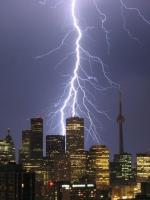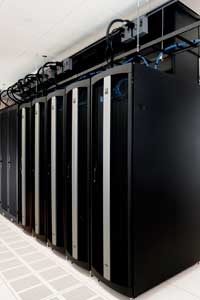Yesterday, we introduced you to the world of modular data centers. Today, we look at how that world is being influenced by an increasingly dense digital infrastructure, and what it reveals about our ability to adapt to new challenges and opportunities in the industry.
 In late June, when one of Amazon's primary cloud storage networks suffered a storm-related power outage in the U.S. Northeast, it was determined that an Amazon Elastic Load Balancing (ELB) service had failed. While the ELB is designed to strategically distribute processing loads across multiple data centers in the event of just such a scenario, the fail-safe didn't function properly. As a result, the network crashed, taking popular sites such as Netflix and Pinterest down with it.
In late June, when one of Amazon's primary cloud storage networks suffered a storm-related power outage in the U.S. Northeast, it was determined that an Amazon Elastic Load Balancing (ELB) service had failed. While the ELB is designed to strategically distribute processing loads across multiple data centers in the event of just such a scenario, the fail-safe didn't function properly. As a result, the network crashed, taking popular sites such as Netflix and Pinterest down with it.
In July, another well-known online tech giant, Twitter, suffered its own downtime when a supposed claim that increased traffic due to the Olympic Games actually proved to be the result of a double failure across core data center operations. In this instance, built-in N+1 redundancies, designed to avoid just such a scenario, both failed nearly simultaneously, causing Twitter’s VP of engineering to remark, “I wish I could say that today’s outage could be explained by the Olympics or even a cascading bug. Instead, it was due to this infrastructural double-whammy.”
Truth is, big data, small data, mid-level data, it all relies on clarity, consistency and properly functioning countermeasures to work error-free. Then again, to err is human, even if the systems we increasingly rely on are anything but.
As the DatacenterDynamics forum discussion we told you about yesterday reveals, the delicate relationship between our global network of data centers and the power systems they rely on is constantly being challenged – whether by unforeseen acts of nature in a highly fluctuating eco-system or the continued complexities of our man-made networks.
 And with greater emphasis now being rightfully placed on energy efficiency within the data center (and to an even greater extent, within the data center’s core components [by way of passive cooling and aisle containment]), there are equally compelling and parallel conversations happening as to how we as data center envoys must establish their long-term place in the world.
And with greater emphasis now being rightfully placed on energy efficiency within the data center (and to an even greater extent, within the data center’s core components [by way of passive cooling and aisle containment]), there are equally compelling and parallel conversations happening as to how we as data center envoys must establish their long-term place in the world.
Whether that place is a state of mind as a new idea or on the ground as a new installation, it represents an understanding that our technological progress depends on physical infrastructure.
And because any physical infrastructure is wrought with challenges (overtaxed power grids, climate concerns, political unrest), the flexibility, scalability and mobility of modular data centers are attracting new followers by the day.
Tomorrow, in our final installment of this week's modular data center series, we'll take a look at who's doing what and how these examples pull the curtain back on the kind of IT infrastructure storage best suited for the job. Jeff Cihocki, Global eContent Specialist